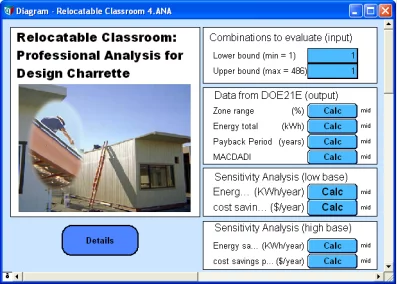
Caroline Clevenger, a Research Assistant and LEED-accredited architect and John Haymaker, Assistant Professor at CIFE, are investigating how multidisciplinary design and analysis processes can lead to improved building performance and reduced environmental footprint.
The challenge
With burgeoning interest in green building, architects are paying closer attention to energy-efficiency and reduced environmental footprint. Due to the difficulty and cost of using detailed software simulations of energy usage in buildings, such as DOE-2 or Energy Plus, few architects use such models to explore tradeoffs between energy savings, environmental impacts, and building costs.
As a more practical alternative, the Stanford researchers are exploring ways to identify key insights from systematic sampling and set-based filters to help designers prioritize and guide the design process. To generate these insights, they needed to perform a large number of experimental runs of a standard building energy simulation tool, DOE-2, as they varied key design parameters.
They also wanted to test whether providing architects with an intuitive summary of such results would actually help them find better design solutions.
Why Analytica?
“We needed a tool to help us conduct a large number of experimental building simulations and analyze the results to find key insights.”
Caroline Clevenger of Stanford’s CIFE
“Analytica’s calculation engine, linked to DOE-2 provided us the ability to perform a meta-analysis of building performance. Analytica was able to run 486 simulation runs with DOE-2 in a few seconds. By ranking the Importance of the six design decisions considered rather than “optimizing” design, we were able to provide designers the information they need to design. Analytica’s interface and statistical tools effectively analyze building performance calculations to provide insights previously unavailable. In the near future, we hope to be able to expand these results to illuminate more robust and complex solution sets.”
The solution
Building simulation and analysis tools are widely available. However, the value of these tools depends on whether they actually help the designer find better solutions among the wide array of possibilities.
To explore how designers navigate a solution space of design tradeoffs between building cost and environmental impact, the CIFE researchers constructed a synthetic experiment: Design teams were challenged to design within budget, the most energy-efficient relocatable classroom.
They had to make six design decisions affecting tradeoffs between initial cost and environmental impact – e.g., insulation thickness, window types, and roof material. Each decision had two or three levels of performance and cost, resulting in 486 design combinations.
Two group types, each with two batches of students were tested. One group of student designers received “Importance” results, showing the cost-effectiveness of each design parameter averaged over the simulations.
The other group followed a more traditional modeled-based design analysis process. The designers were Master level students armed with limited knowledge of sustainable design principles. Each group’s design analysis was tracked step by step and evaluated against a single assessment value.

The results
Preliminary results demonstrate that design teams given “importance” information showed consistent improvement in how they navigated the solution space over those that were not. “Importance” is a measure of the sensitivity of building performance to each design parameter using the rank correlation between performance and each parameter.

The efficiency of the design process (predicted performance / number of analyses performed) increased significantly with the introduction of Importance information.


Preliminary results support CIFE researchers’ intuition that full characterization of constraints is extremely difficult in the field of green building.
Analytica’s calculation engine, capable of evaluating Importance, provides a valuable tool, relieving designers from cumbersome “point-based” analysis and guiding them toward improved solutions.
In other words, information about importance tells designers where to spend their design time, not what the final design should be.
Authors


For more
Center for Integrated Facility Engineering (CIFE), Stanford University.




